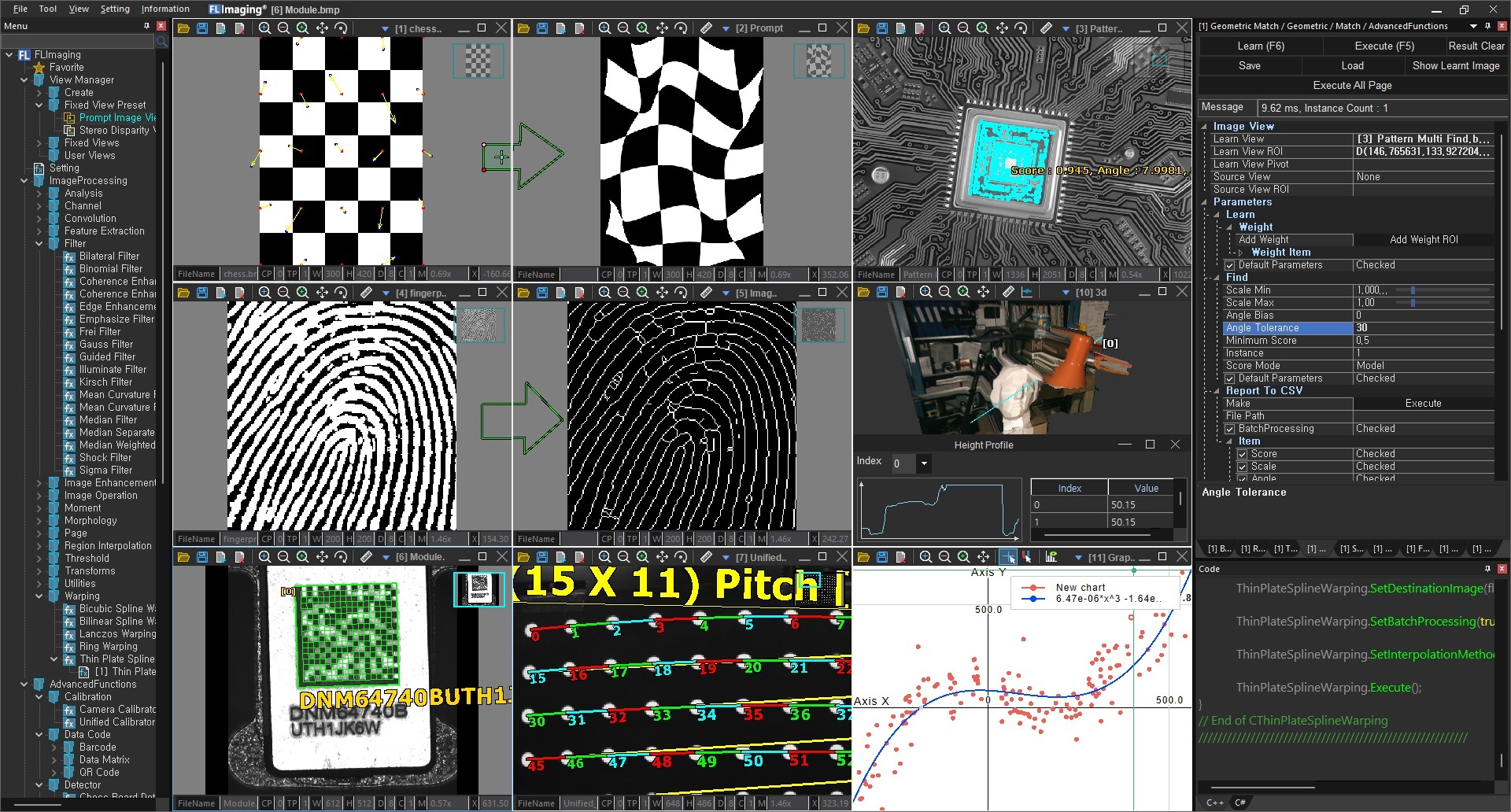 Product
Product FLImaging®
FLImaging® Product
Product FLImaging®
FLImaging®
FLImaging ®
FLImaging® Introduction and API Reference: https://flimaging.fourthlogic.co.kr
FLImaging® is the world's most powerful and feature-rich image processing and deep learning library developed 100% in Korea, supporting both rule-based and deep learning approaches.
Why use FLImaging®?
Supports rule-based and deep learning approaches
Supports almost all existing image processing algorithms
Supports optimized algorithms for all algorithms
Supports parallel computation through SSE4, AVX2, and multi-threading for all algorithms
Supports high-speed mathematical computation library including planar coordinate curve mapping algorithm for vision and equipment development
Provides rich example codes for C++/C# each 250 kinds
Supports visual programming
The AI image processing platform, FLImaging®, provides both conventional image processing techniques and AI image processing through deep learning.
Through this, it is possible to respond immediately to any vision development requirements and provide powerful image processing performance.
It supports distribution-based pattern matching, geometric pattern matching, precise measurement of various shapes, barcode, data matrix, FFT, QR code, OCR / OCV, fastest labeling algorithm, high order equation solving, and geometric calculations,
It provides high-speed matrix calculations for artificial intelligence and various regression functions, and provides an artificial intelligence inspection solution consisting of well-trimmed neural networks.
FLImaging® users can easily achieve their goals by obtaining training images without much difficulty, and can easily achieve stability and inspection goals by utilizing precise and fast conventional expert systems.
Basically, algorithms are provided with SIMD computation, which makes them fast, and the computation unit can be changed from multi-core or GPU depending on the user's settings without modifying the developed code.
FLImaging® is currently being used in vision equipment in the semiconductor industry and is well-received by customers.
Simultaneous support of classic image processing algorithms based on Expert System and AI-based (Deep Learning)
Both approaches have their own advantages and disadvantages, and simultaneous support allows for immediate response to any vision development requirements.
Deep learning is advantageous for object recognition / discrimination and defect inspection, but it requires a large amount of good and defective image information.
In reality, it is quite difficult to obtain a large amount of image information in the development stage.
In addition, deep learning does not offer much advantage in cases where the method to derive the result is strictly defined, such as algorithms for reading codes through a predetermined logic of barcode, data matrix, and QR code, or algorithms for measuring dimensions.
Through the development of Deep Learning neural networks that apply the optimized algorithm of the existing expert system algorithm,
Provides stronger inspection performance compared to other Deep Learning products,
Program development is possible by selecting only the advantages of each method, and competitive image processing software can be developed.
FLImaging® provides an ALL IN ONE image processing platform that can utilize these two simultaneously.
Fast and reliable image processing
FLImaging® provides fast speed and reliable inspection capabilities to users.
SIMD (Single Instruction Multiple Data) is supported by default in all algorithms, so the speed is fast in single threads.
Various computation units can be utilized, and the computation unit for image processing can be changed without modifying program code by adjusting options.
If you have a multi-core CPU: Algorithms that can take advantage of the SIMD-enabled CPU multi-core without additional cost perform high-speed inspection.
If you have a high-speed GPU: Super high-speed inspection is possible through GPGPU computation assistance.
Intuitive and consistent API design
The basic structure of all image processing APIs has the same structure, so with only one API knowledge, it is consistent structure that there is no difficulty in using all other APIs.
Relieve programming stress through flexible abstraction design / relatively less bug occurrence possibility through clean code.
Visual development possible through FLImaging® FLImaging SNAP® development method
FLImaging® FLImaging SNAP® is a technology that allows you to program image processing sequences created through conventional programming simply by placing and connecting each component like a block toy and drawing pictures.
You can visually check the entire program, even beginners can easily check the program overall.
Run the program developed by FLImaging® FLImaging SNAP® in the programming language
Programs developed with FLImaging® FLImaging SNAP® can be run directly without adding code in C ++ / C #, etc.
Even when changing the development manager or collaborating, handover and collaboration are possible by checking the visual diagram of FLImaging SNAP® without reading the code by other managers.
Program status and visual debugging support that can be checked at a glance for programs developed with FLImaging® FLImaging SNAP®
You can visually check the current progress when the program is running.
If a developer encounters a problem with their program, they can fix the problematic part without closing the program and continue without closing it.